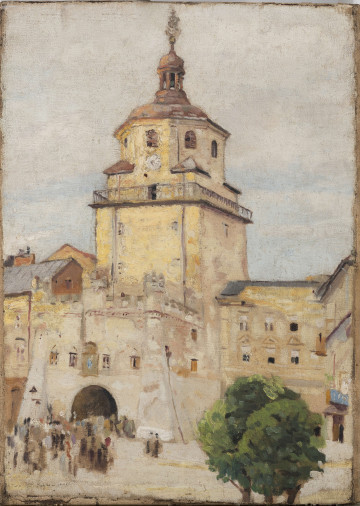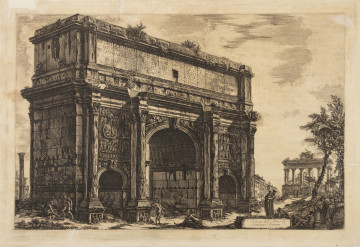
Krakow suburb
circa 1926-1939
National Museum in Lublin
Part of the collection: Lubliniana. Painting views of Lublin and the Lublin Region (17th–early 20th c.)
Marcin Zaleski's painting shows a fragment of old Lublin. It shows part of the city centre – Krakowskie Przedmieście Street in the vicinity of Krakowska Gate, the entrance to the Old Town. Such a shot, composed only of architectural elements, or, as in Zaleski's case, with genre development in the form of staffage, was often chosen by graphic artists and painters depicting the city on the Bystrzyca River. With time, it became an emblematic iconographic motif of Lublin. Its various versions can be found in numerous examples: by L. Urmowski, F. K. Dietrich, A. Orłowski, W. Gerson, L. Wyczółkowski, and S. Trachter.
Zaleski's work probably dates from the artist's early period, from around 1820. The assessment is supported by its artistic level which does not match the achievements of the mature phase of his career, but also by the fact that the depiction faithfully repeats the scheme used by several printmakers (for example, F. K. Dietrich) that indicates that it was very likely made based on some selected engraving. The painter sometimes used this method in later years as well, when making commissioned views of various places. Transferring a graphic composition into a painting version could also be a kind of practical exercise. As a self-taught artist, Zaleski acquired technical skills by copying the works of famous masters. As a young man, he practised in Warsaw's theatre decorator's shops, where he perfected his skills in perspective. Thanks to his efforts, innate talent and artistic self-knowledge, he managed to develop his style, in which there is no trace of reproductive, secondary imitation. Marcin Zaleski is considered the most outstanding Polish Vedutist of the 19th century. He left many views of Polish cities. He was one of the few artists in the world of Polish painting to depict the interiors of monumental buildings such as churches and public buildings. The cityscapes and interiors presented by the artist – with his exquisite use of convergent perspective, soft colours and attention to the minor details – often constitute the only record of the appearance, sometimes even proof of the existence of specific spaces or individual buildings of Warsaw, Krakow or Vilnius, destroyed by various events, mainly during the Second World War.
Bożena Kasperowicz
Author / creator
Dimensions
cały obiekt: height: 22 cm, width: 17 cm
Object type
painting
Technique
oil technique
Material
canvas, oil-based paint
Creation time / dating
Creation / finding place
Owner
The National Museum in Lublin
Identification number
Location / status

circa 1926-1939
National Museum in Lublin

1921
National Museum in Lublin

not before 1783
National Museum in Szczecin
DISCOVER this TOPIC
National Museum in Szczecin
DISCOVER this PATH
Educational path